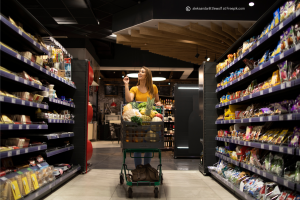
Many shops now offer their customers alternatives to the traditional checkout, whether it’s for sportswear, DIY supplies, or furniture purchases at a well-known Swedish furniture store. In Germany, the use of self-checkout terminals and mobile self-scanning systems continues to grow. The food retail sector is also expanding in this area, demonstrating that the solutions already known are just the beginning.
Stationary and mobile – digital solutions on the rise
Companies are increasingly integrating self-checkout solutions into their shops to provide additional customer service, shorten waiting times and eliminate tedious processes such as repacking goods at the checkout. Our ALVARA Self Service Kiosk Manager offers intuitive usability for customers, making the switch to digital solutions easy.
According to the EHI Retail Institute’s 2023 market analysis, there has been significant growth in this area over the past two years. In 2021, 2,300 shops used the new approach, which increased to over 5,000 shops in 2023. The analysis excludes pilot and test stores, making further expansion realistic. The development can be divided into two distinct offerings. 4,270 shops offer stationary self-checkout tills to their customers, while 2,150 shops use mobile self-scanning systems. Additionally, 1,400 shops offer both alternatives to their customers.
Compared to the stationary self-checkout solution, where goods are scanned and paid for collectively at the end of the purchase by the shopper themselves, the mobile self-scanning variant relies on customers using handheld scanners, shopping trolleys with scanners, or an app on their own smartphone to record goods during the purchase. Self-checkout alternatives are commonly found in food retail (60%), drugstores (15%), DIY stores (15%), furniture stores (2%), and other shops (7%).
Shopping 2.0 in the food retail sector.
However, the technologies that have been used so far – stationary self-checkout and mobile self-scanning – are still at an early stage of development. Discounters and supermarkets have been competing with each other for several years by opening new test shops to evaluate and exploit the potential of these technologies. The goal is to make shopping as convenient and intuitive as possible.
Last year, Aldi explored the trend of artificial intelligence by implementing it in their checkout process. The company discovered how to use technology to create added value for customers. With the help of AI and cameras, shoppers can now easily check out fruits and vegetables without having to navigate through an extensive list. The system can recognise the products in a matter of seconds.
Rewe is testing a new shopping model called ‘Pick&Go’ in scattered pilot stores in Cologne, Berlin, and Munich. This model eliminates the need for scanning and checkout processes, saving customers time. To use this model, customers need to download the REWE Pick&Go app on their smartphone, create an account and enter their payment method. At the entrance, they can scan the QR code on their mobile phone to start shopping. Customers can take products from the shelves as usual or return them if they are not needed. The difference is that a camera records the items and the bill is settled via an app after leaving the shop.
This provides a new shopping experience that eliminates the biggest annoyance of queuing at the checkout. It is a balanced approach that benefits both customers and employees. Retailers emphasize that despite the new technology, they are not reducing staff.
Optimising Customer Experience at the POS for SMEs
For smaller shops, bakeries, direct producers, or farm shops, improving the customer experience may seem like a distant goal. However, they can still benefit from technical support to enhance the customer experience. Modern checkout systems offer many advantages. For instance, our ITR checkout can optimise checkout processes, speeding up operations. Additionally, returns management for undecided customers and product allocations are expedited. The text should also adhere to conventional academic structure and formatting, with clear and concise language and precise word choice. Customers can also pre-order products, resulting in reduced waiting times. The waiting time for customers is reduced.
If you do not wish to charge your device while on the way to shopping 2.0, let us work together to find a suitable solution.



